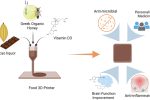3D Printed Cacao-Honey Formulations Aim to Enhance Vitamin D3 Delivery
A recent study from Queens University Belfast has employed 3D printing to create cacao-based formulations infused with raw Greek honey and vitamin D3 (VitD3). The researchers aimed to improve supplement delivery by addressing taste and bioavailability issues. Their approach involved blending organic cacao with varying concentrations of honey and introducing VitD3, using specialized 3D printing technology to form precise, stable printlets.Three honey typesVitex Honey, Lavender Honey, and Jerusalem Sage Honeywere each melted at 37C and incorporated into 100% organic cacao liquor. The team prepared two concentrations, 5% and 10% (w/w), to identify how varying honey ratios affected the resulting mixtures. Physicochemical tests indicated that the chocolate-honey formulations stayed liquid-like under ambient conditions and remained stable up to around 38C. Rheological analyses revealed that adding honey increased viscosity, enhancing the structural stability of the 3D printed shapes.Graphical abstract. Image via Science Direct.Lavender Honey at 10% concentration emerged as a balanced choice in terms of viscosity and compatibility with VitD3. Thermal assessments confirmed that VitD3 was dispersed uniformly in the chocolate matrix, adopting an amorphous form conducive to consistent dosing. Researchers found that higher honey content slightly prolonged disintegration times, raising the possibility of a more controlled release profile for VitD3 in an oral setting.CHOC EDGEs Choc Creator V2.0 Plus, a specialized chocolate 3D printer, was used to build precise layers of tempered cacao. The device operates through semi-solid extrusion (SSE), a process that deposits low-temperature, gel-like materials layer by layer. SSE technology preserves heat-sensitive componentssuch as honeys bioactive compounds and VitD3while maintaining the required viscosity for intricate chocolate designs.After mixing honey and VitD3 into cacao at around 80C, the formulations were cooled to roughly 32.5C and loaded into a temperature-controlled aluminum syringe. The printed shapes20mm by 20mm squares with a thickness of 1mmwere then allowed to cool at room temperature. Dimensional evaluations of each formulation demonstrated consistent geometry, though the inclusion of honey influenced final weight.Graphic illustration of (A) 3D design from TinkerCAD (B) 3D sliced design using Choc Print software and (C) 3D printed cacao-based formulation. Image via Science Direct.Assessing Palatability, Structural Integrity, and Antibacterial AspectsOne objective of this work was to address palatability issues that often limit patient adherence to supplement regimens. Honeys widely accepted sensory qualities could mask any bitterness arising from active pharmaceutical ingredients. Texture analysis showed that different honey concentrations influenced mechanical strength. Some printlets with higher honey content had increased firmness, while others showed no significant difference under the chosen parameters.Researchers also evaluated the antibacterial properties of raw honey before and after printing. Although raw Lavender Honey inhibited bacterial strains such as Staphylococcus aureus and Escherichia coli at specific concentrations, the final printed products did not show measurable zones of inhibition during disk diffusion assays. The study attributes this result to several factors, including potential dilution of antibacterial compounds during printing and the need for higher honey concentrations to form visible inhibition zones.Next steps proposed in the study include conducting sensory evaluations, exploring larger-scale printing, and assessing additional active ingredients or nutrient combinations. The authors suggest that 3D printed chocolate-honey supplements could pave the way for more personalized, on-demand healthcare solutions, particularly when precise dosing and patient-friendly formats are essential.Optical microscopy images depicting the physical characteristics surface morphology and colour, of the different honey varieties (LH, VH, and JH) under three storage conditions: (A) ambient (20.0 C 0.5 C), (B) refrigerated (5.0 C 0.5 C) and (C) freezer temperature (20.0 C 0.5 C). Image via Science Direct.Ready to discover who won the 20243D Printing Industry Awards?What will the future of 3D printing look like?Which recent trends are driving the 3D printing industry, as highlighted by experts?Subscribe to the 3D Printing Industry newsletter to stay updated with the latest news and insights.Stay connected with the latest in 3D printing by following us on Twitter and Facebook, and dont forget to subscribe to the 3D Printing Industry YouTube channel for more exclusive content.


